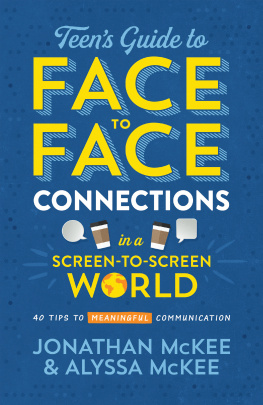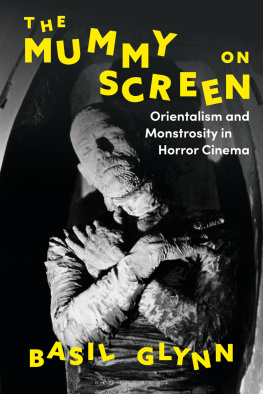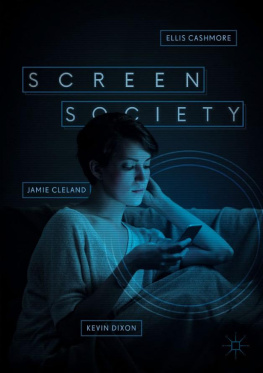The Screen
Media Reader
The Screen
Media Reader
Culture, Theory, Practice
EDITED BY
STEPHEN MONTEIRO
Bloomsbury Academic
An imprint of Bloomsbury Publishing Inc
For Manisha and Dhruv
This book is designed as a foundational resource in the study of the screen and its cultural role. It contains some of the most important and stimulating work done in this area, while suggesting potential paths for further research and study. Through key historical and interpretative texts on the development and place of the screen in communications and the social sphere, it offers explorations of the screen as an idea, an object, and an experience through a variety of descriptive and analytical approaches. Readings have been chosen to illustrate the astonishing range and depth of the screens applications and invocations in multiple media configurations and contexts. As such, the reader brings together texts from diverse sources that nevertheless share an interest in the screen as an element of popular culture and an agent in our understanding of the world around us. Work principally concerned with audience characteristics or the narratives that screens deliver have been left out, as these are abundantly available in other readers on visual media and communications.
A few of the essays appearing here may be familiar even to those coming from outside media studies, while other entries have had much less exposure. The decision to select existing texts rests on the desire to serve two important functions with this book. First is the need to provide historical breadth that contextualizes thinking about the screen across different stages of its development as a primary tool of visual communication. Second is the affirmationthrough these examplesof the long-standing and fundamental role screens have played in scholarship as well as society, extending well beyond our often short-sighted sense of twenty-first-century screen saturation.
The contents are organized into three sections: Screens and Their Histories, Images and Frames, and Environments and Interactions. To avoid any hint of historical or technological determinism, texts within each section are not presented in strict chronological order but arranged to generate new relationships across the selections and the ideas they contain. While the three sections are organized to suggest defining characteristics of the screen and its cultural application, there is nothing definitive about this structure. Other categories and ways of organizing these essays are possible, and dialogues and correspondences can be traced across the sections. Indeed, sampling texts within and across sections without adhering to the established sequence may produce additional, valuable insights into the screen and the terms of its study. It is also expected that researchers and students may not read all the texts collected here, but rather draw from the contents as suits their specific interests and goals. It is hoped that any research or study project that commences here will continue to other books, sites, and archives. To that end, each section begins with an introduction framing the primary issues and key questions considered within that part of the reader and the book closes with a bibliography for further reading.
The opening section, Screens and Their Histories, introduces several major voices in the study of the screen. The essays gathered there may be considered founding texts for the field. They reflect multiple approaches and methodologies to studying the screen, while also introducing critical concepts that return at other points throughout the texts that follow. The middle section, Images and Frames, concentrates on those writings that examine the screen as a framing device for images and other visual information. The texts chosen here cover multiple media forms and historical periods to demonstrate recurring ideas in the form and perception of image-screen relationships. The closing section, Environments and Interactions, brings together texts examining the material and spatial properties of screens, whether strictly as objects or as components within larger technological and architectural structures. It introduces ideas concerning the functioning of screens in different contexts and the role of the viewer or user. It demonstrates the screens dependence not only on associated technologies and telecommunication structures, but also shifting socio-economic conditions and cultural practices.
The only certainty in studying the screen is that this object of such importance to contemporary living is bound to take new forms and be employed in new ways, towards unanticipated ends, as technological, economic, and cultural pressures and expectations change. Any subsequent edition of this reader will reflect such developments. Nevertheless, even with these changes, the ideas, opinions, and methods presented in this volume should remain relevant to future considerations of the screen as both a symptom and agent of modern and contemporary visual culture.
The ideain fact, the needfor this collection arose when I developed a seminar on contemporary screen culture. I am grateful to the intrepid students in that course, whose response to the subject and its scattered literature informed my choices for the structure and contents of this book. The project has benefitted from the advice and support of several people, some of whose work appears in these pages. I am particularly indebted to Nicholas Mirzoeff and Murray Forman, both of whom have edited field-defining readers, for their valuable guidance in the earliest stages. I have also benefitted from the remarkable support of my editor at Bloomsbury, Katie Gallof, whose enthusiasm and support has never flagged, and editorial assistants Susan Krogulski, Michelle Chen, and Mary Al-Sayed. The readers for the press offered wise counsel, which I have done my best to heed in the final manuscript. I am grateful to all the authors, publishers, and organizations granting permission to publish the works presented here. I am particularly appreciative of those who were willing to do so at little or no expense. My family always has been a positive influence on my work. Manisha Iyer and Dhruv Iyer Monteiro have taught me much that I might otherwise never have learned about these magic windows and their diverse applications. The deepest roots of this book reach into my childhood and the many hours I spent around screens, long before I had any thought of studying them. The solid-state TV console, the drive-in, the handheld electronic games, the video arcade, the home slideshows, and the multiplex all cast their shadows here. Mindful of that, I am indebted to those guiding figures from my youthsome of them now gonewho did not equate screen time with wasted time.
The following texts are reproduced with kind permission. Every effort has been made to trace copyright holders and obtain permission, but this has not been possible in all cases. Any omissions should be brought to the attention of the publisher.
Acland, Charles R. The Crack in the Electric Window. Cinema Journal 51, no. 2 (2012): 169173. Copyright 2012 by the University of Texas Press. All rights reserved. Used by permission.
Atkinson, Sarah. Beyond the Screen: Emerging Cinema and Engaging Audiences. New York: Bloomsbury, 2014, 61100. Sarah Atkinson, 2014, from Beyond the Screen: Emerging Cinema and Engaging Audiences, Bloomsbury Academic (US), an imprint of Bloomsbury Publishing Plc.
Baladi, Lara. When Seeing Is Belonging: The Photography of Tahrir. Broadsheet







